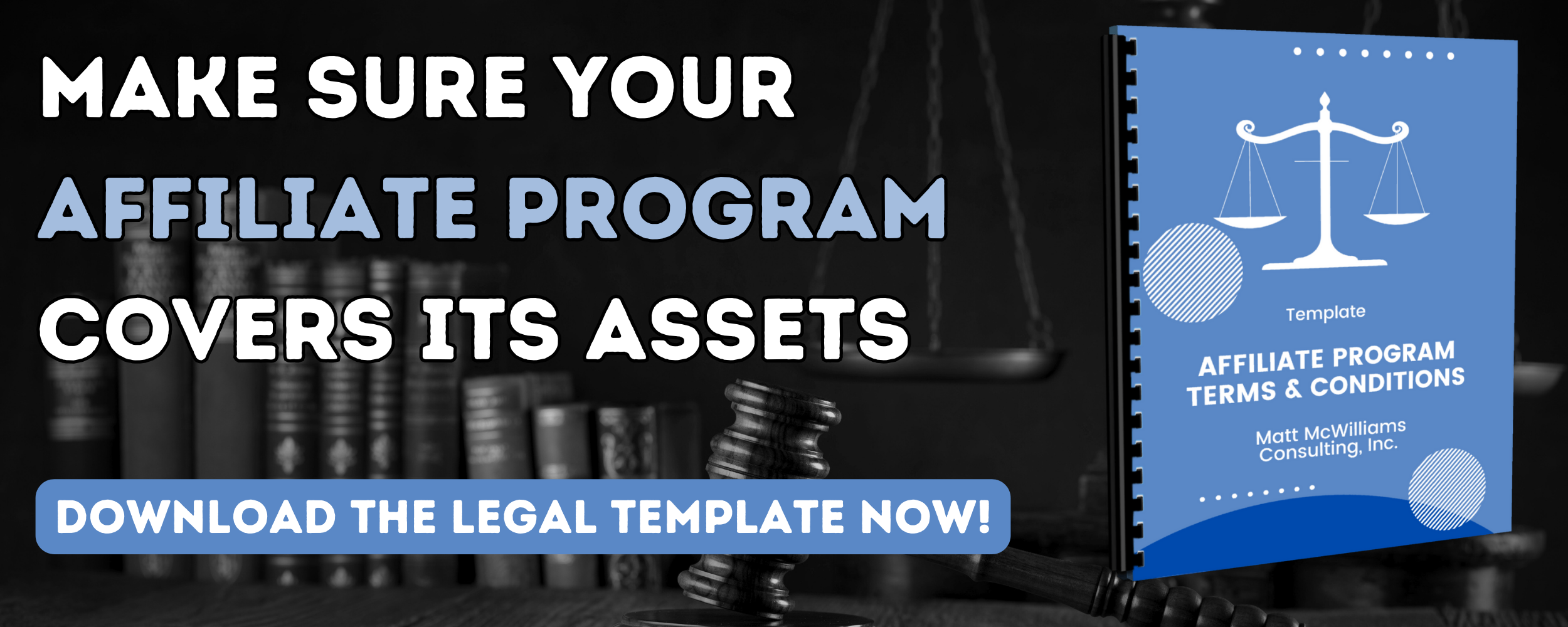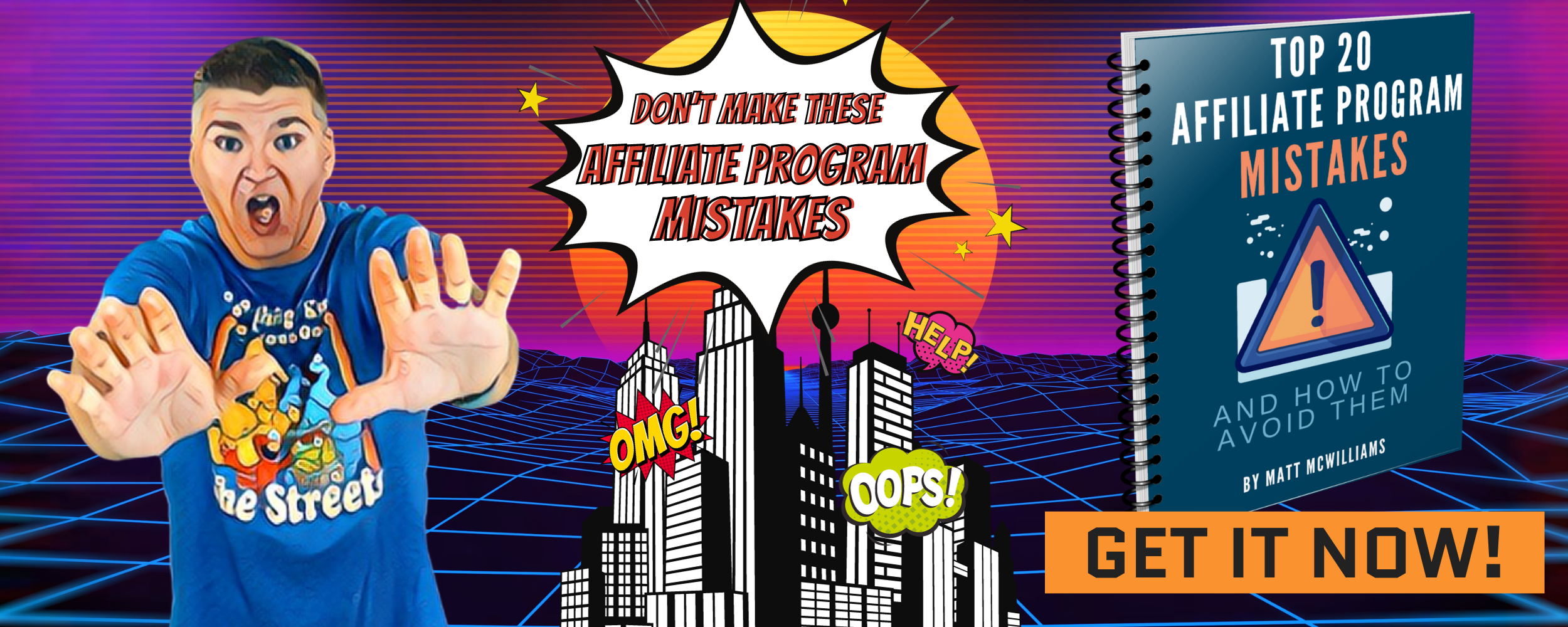Today, I’m sharing a story I’ve never shared before…the story of how I took an affiliate program from $15 million to a staggering $325 million annually in just four years. Yes, more than 20X growth in only 48 months. I share everything…all of the basic principles and secrets I’ve never revealed publicly that worked…and a few things that didn’t. Some of the methods I share might surprise you!
Click Here for The Written Transcript of This Episode
Get the EXACT Template We Give to Our Affiliates to Get Them to Promote More and Generate More Sales! Click Here to Download it Now!
Links Mentioned in this Episode
Affiliate Training Templates and Scripts
TEXT ME: 260-217-4619
Don’t Miss An Episode – Subscribe Below
Previous Episodes of The Affiliate Guy
How to Create The Right Affiliate Commissions
Top 14 Reasons Your Affiliate Program is Failing (And How to Fix It)
How to Steal Your Competitors’ Affiliates
How to Create High-Converting Swipe Copy for Affiliates
How to Create an Affiliate Program Agreement
What are the Legal Requirements for an Affiliate Program?
How I Grew a Major Affiliate Program from $15M to $325M a Year (In Only 4 Years)
Today I’m sharing a story I have never shared before. The story of how I took an affiliate program from 15 million a year to a staggering 325 million annually in just four years. Yes, that is more than 20 x growth in only about 48 months. I’m going to share everything, all of the basic principles, all of the secrets I have never revealed publicly that worked and maybe even a few things that didn’t. Some of the methods I share might surprise you.
So listen up. Let’s get started. So that I know of. I’ve never shared this story before. I’ve probably, as I was thinking about this, I was thinking, you know, I know I shared at least one little part of it earlier this year and it was kind of the first time I shared that.
And obviously I’ve shared some of the principles here and there and throughout different episodes, but I’ve never shared this story in its entirety. And it’s the story of how I took one affiliate program from right at 15 million a year. When we took over to four years later, we were doing 325 million that year.
Now, I am not going to say who this company was, in part because I’m going to mention some specific people without mentioning their names and I don’t want to call them out, but this company, it’s a publicly traded retailer. Now, we’ve worked with dozens of companies like that, so you can’t figure out who it is. Huge, right? And I am not going to share the exact numbers because you could google these exact numbers and possibly figure out who it is.
But their revenue last year was over $2. 25 billion. Okay, over 2.25, not much over, but right around there. At the time I took over the affiliate program in 2010, their annual revenue was about $300 million.
Their affiliate program accounted for less than 5% of that. When I stopped working with them in 2015, they did $1. 1 billion in sales, with the affiliate program accounting for 32% of allsales. In other words, we did more in affiliate sales in 2015 than the entire company did in 2010. That’s the kind of growth we had.
Need help activating your affiliates? Use my proven email templates for getting inactive affiliates in the game and making sales! Get them here!
So the question, of course, is how did we do it, you know, and as I looked back and thought about it, I found five things that we did specifically that contributed the most growth. Could I do a 50 point podcast about every little thing we did that contributed an additional 100,000 in sales. Absolutely. I’m not going to do that, though. I’m going to share five big things. I think these were the five core principles that were all worth, I’m going to say, more than $20 million individually. And of course, the cool thing about them is they stack on each other and I’m.
I’m going to share them in no specific order because they are all important. If I do a countdown from five to one, you’ll focus on number one, maybe number two, and that’s it. The reality is that doing any one of these things, or even two or three will only get you half the results of doing all five. And so I actually am going to do them in some sort of an order.
And that is the order in which we implemented them is I’m going to do this in chronological order. So I guess there is a particular order, but the reason why it’s chronological, it’s not just, to be clear, is not most important. Least important of the five, they are all equally important.
And like I said, they compound. You know, if all we do is the first thing, we might have grown to 50 million. But we did one and two, which got us to 80. We did one, two and three, which got us to 140. We did one, two, three and four, which got us to 230. We did 1234 and five, which got us to 325.
The combination of these five things, plus the magic factor of time, you know, it did take us four years now, to be clear. Still pretty awesome that we more than 21 x in four years, when we do all five of these things, plus time, I can promise you, you will grow.
All right, so let’s jump into what we did to really grow that particular affiliate program. The first thing we did was we focused on one affiliate type at a time. You know, there are literally dozens of different types of affiliates you could work with. There are coupon sites, there are co red sites, there are mommy bloggers that other content creators, YouTubers, instagramers, people who are big on Facebook, people who are big on TikTok deal blogs, all these different types of affiliates.
Well, when I first took over, one of the very first things we did was we sat down with the CEO, and I’m going to call the CEO Greg. Nice generic name there, right? Actually, come to think of it, I have worked with a CEO named Greg. It’s not him. Just so you know, their numbers aren’t nearly that big. So if you happen to know who I’ve worked with and know that I once worked with a CEO Greg, it’s not him, okay? And he was like, okay, you got to go after a bunch of different types of affiliates.
Here’s how we’re going to grow. We have a vision for how we’re going to grow, and here’s what we want you to do. We want you to go after mommy bloggers and deal blogs and nonprofits and photographers, and we want you to go after all these ten different types of affiliates.
I was like, greg, no, that will not work. We have to focus on one type of affiliate. At first, the old saying that I shared with him was, you know, we don’t want to go a mile wide and an inch deep. We want to go an inch wide and a mile deep. I said, we need to really lean in to focusing on one type of affiliate. And I went on to explain not only my theory, but my experience that here’s what’s going to happen. This is what I explained to him and what ended up happening, what I predicted, what happened. Did I say, here’s the thing, we need to focus on one, one type of affiliate.
And we go out and we work our butts off to get one type of affiliate, and we go take days to get the first one, and then we take less to get the second and the third, and then one of them starts having some success. And we can use that as an example for the next one, which makes it easier to get the next one. And now we’re adding one a day and then one and a half a day and then ten a week, and then we’re adding 20 a week and the next thing you know, we’re going to grow from there. I said, that’s how this is going to work.
I said, they talk to each other, they mastermind with each other, and we need to focus on one type. And so I picked mommy bloggers. Now, I know they hate that terminal. I’m just saying what the term was back then, back in early 2011, it was mommy bloggers. I said, I’m going to focus on them because I knew some and I knew that I could get ten or twelve really fast to sign up.
I might even be get like 20 or 25 pretty fast, like in the first week or two. And so that’s why I picked that. And so what I had predicted would happen is exactly what happened. I worked hard, I reached out to them. I got about 15 to 20 pretty fast, and then I worked hard to get more. And I asked for introductions. You know, I talk about that all the time.
Your number one source of new affiliates should be your current affiliates. So I focused on the Mommy blogger affiliates that we already had in the 15 or so that I brought on, and I asked them, and next thing you know, we’ve got like 75 to 100 mommy bloggers pretty quickly. But then I worked really hard to recruit one new one and then another new one and then another new one.
And so what happens over time is when you have, let’s say, five, you have five mommy loggers, five nonprofits, five deal blogs, five photographers, five coupon sites, five loyalty sites, you have five of each. Then the promotions are so sporadic that none of the others really see them and notice them. But what happens when you get to 100 of one type is now all of a sudden, and you know this, mommy bloggers follow other mommy bloggers. Deal blogs follow other deal blogs. Nonprofits follow other nonprofits.
Right? The way I was saying that just made me think of Charlie and the chocolate factory. Willy Wonka and the chocolate factory. And he’s like, the strawberries taste like strawberry. The snozzberries taste like snozberry. Sorry. Okay, that was my add moment for this episode.
Back to what we’re talking about, you know, so they start seeing multiple promotions in a day, and then all of a sudden, when you have a deal, maybe five or ten affiliates are promoting it that an individual mommy blogger is on their list or follow them on social media.
And now they’re seeing this program everywhere. And it got to the point, as we grew and grew, and it literally, we went from getting one a day and working my b*** off to get one a day for the first couple of months to two a day, three a day, five a day, ten a day, literally 15 to 20 per day during peak season. And it got to the point where it was like, step one, register your domain.
Step two, set up hosting, you know, WordPress. Step three, register for this affiliate program. Because if you followed anybody that was a mommy blogger, they were all promoting this company. And so I got the nickname from somebody. It was king of the Mommy bloggers, right? Ironic nickname. And so we focused on one.
Okay, from there, we’re getting 15 to 20 mommy bloggers signing up every day without actively recruiting them. It’s no longer worth actively recruiting new ones. We got all the big ones. We got, like, the top 250, and we’re getting all these new ones setting up every day. We’re well known. I don’t need to actively recruit any of them.
So we moved on to photographers, and I didn’t know any. Actually, I knew one. A friend of mine from Franklin, Tennessee. And I did reach out to him, and he, I think he introduced me, like, two more, but that was it. And so we specifically focused on wedding and engagement photographers.
And then we moved on to baby photographers, then graduation. And then we were, you know, that was most photographers at that point, but we reached out to hundreds a day, but we’d get one or two to sign up. But then, like I said earlier, after we got like 20 or 30 and a few of them started having success. Now we had case studies and, and our signup page got better. And now we started getting multiple photographers in an area.
And if you were a photographer in that area and you followed photographers in your area, all of a sudden two of them promoted us in a week. Well, that’s interesting. And then three promoted us, and now it’s like, okay, now all of a sudden, after a few months of really hard work, we started getting a couple a week to sign up that we didn’t even recruit. And then another month goes by and all of a sudden we’re getting one a day. Same thing. Two months later, we’re getting two a day, three a day, four day. They were flooding in.
So at that point, when we kind of tap that out, where we were getting more people signing up than we could conceivably actively recruit, we knew it was only a matter of time before we’d have almost all of them. So then we moved on to the deal blogs, and we specifically focused on loyalty sites, and we did the same thing. Then we did coupon sites, then we did nonprofits. But even with the nonprofits, we specifically started with PTA’s and ptos. And we specifically started with PTA’s and ptos in a certain geographical region. At that time, we started with them in the northeast because we had connections there.
And so that way we were only working with PTA’s and ptos in the northeast. And then we expanded to the rest of the country. And then again, it got to the point where we were getting two to five per day signing up, which was more than we could actively recruit. So we moved on to other types of nonprofits, children’s hospitals, and then other types from there.
And as they began to see what others were doing, they signed up. So this was so important to us. And one of the biggest reasons it worked was because we had that saturation. We reached that point of saturation where, like I said, it was step one, register your domain. Step two, sign up for hosting.
Step three, sign up for this program. And this is how we went from having only about 5000 affiliates when we took over to having more than 125,000 when we left. We stopped working with them four years later. What’s the math on that? Yeah, we 25 x the number of affiliates. Newsflash, we 21 x’ed the sales. Makes a lot of sense, doesn’t it?
Now, none of that is possible, or very little of that is possibly none of it. We probably could have taken it from 15 to 100 just on that, maybe even 140 or 50, but there’s still a lot to go to get to 325. So the second thing we did was we changed how we communicated with affiliates. Now, I don’t mean how we communicated, my company communicated how I personally communicate with affiliates.
I’m talking about how we as the affiliate program communicated because when we took over it was basically a weekly mass email newsletter. That was it, 52 emails a year, every week at about the same time to everyone. No individualization, no segmenting, nothing more than the 52 because there apparently there was some unwritten rule that said you can only send one email a week and it has to be in a newsletter format of it has to go to everybody and say the exact same thing. That doesnt work. We know that.
So we started individualizing a lot of the emails. We started reaching out to affiliates with weekly milestones and goals and specific promos that were only for certain affiliates and we knew that certain segments, that is, once we got it up and running the nonprofits didnt care about certain things so we left them out which allowed us to send more emails that were very specific to the affiliates. We started sending a lot more emails, like a lot more but to an individual affiliate they might only get three of them in a week.
And so this was an example. One of the advantages that we have as a company is because we work on a lot of evergreen programs and at that time I had worked on a lot of evergreen stuff, but I’d also worked on launches, I’d worked on book launches and I’d worked on product launches and I’d worked on. They weren’t super popular back then, but I was starting to work on things like summits. So these event based promos. Right. So we were able to bring some of the excitement and the ferocity of a launch into evergreen world and we treated each promo like a launch.
So there might be a site wide sale this week or there might be a three day sale and then there might be this thing. And so each of these is now suddenly its own promo with its own launch like thing that has three, four, five plus emails in a week, all about a specific thing rather than one giant email that covers five things.
So we started segmenting the affiliates and yeah, as we grew and we had 50,000 affiliates, there might be an email that only went to 8000 in that same day. There was one that went to 12,500 and there was one that went to another 30,000. There was one that went to the other. Might be a little bit of overlap and that might mean, you know, heaven forbid, right?
You got two emails in a day about different things instead of one email a week. With five things, we started doing more phone calls and more strategy sessions with individual affiliates and small groups of affiliates, which, by the way, if you want to get a template for that, I’ll put the link in the show notes. I think it’s Matt mcWilliams.com aff an aff plan.
We will edit that if that’s not the link. So. And you’ll hear a voiceover from a, um. We’ll probably pick somebody with like a really, really good baritone. I’ll have James Earl Jones come in and like all of a sudden you’ll get the right URL. But either way, we’ll put it in the show notes and you can get a template for those phone calls and the strategy sessions. We did all these things that individualized the communication and took that communication to a new level. When we announced a contest, one of the biggest things we did, we did tons of contests and we’ll talk more about contests later.
But they used to run like one contest every quarter and we were suddenly running one. It was like three day contest, two day contest, one day contest, weekly contest. But we required them to opt into the contest. Now there’s two things that did. So let’s say we ran a weekly contest. Like we’re going to run a big contest next week. Top affiliate earns $2,500, 2nd place, thousand, third place, 500, whatever it is, right? Or however we did the contest, we did all kinds of different contests.
I am talking 50 different contests a year, maybe more. And some of them were like, every sale earns you an entry. So if you make five sales, you get five entries you could win versus, you know, if it’s top affiliate, second affiliate, third affiliate. A lot of the contests were, make a sale tomorrow and you’re entered to win. If you make 50 sales, one sale doesn’t matter. We’ll talk more about that a little bit.
But we required them to opt into the contest. Now, this did two things. Number one, it saved us a ton of money from people accidentally winning something. So somebody win a prize like, oh, I didn’t even know I was in a contest. Well, then they didn’t do anything to win it. We want people who are actively going to participate, so we would require them to respond back or fill out a form and say, I’m in.
And so we’d have 2800 people sign up. Only those 2800 people were entered to win the contest. That was number one. The second thing it did was we could communicate with them differently because I knew these 2800 people are going to promote this specific product Tuesday and Wednesday, and they’re in this contest, right? So I’m going to go overboard with communication next Tuesday and Wednesday. So I’m going to communicate with them the Friday before and really lead into it over the weekend.
I’m going to send an email Monday, I’m going to send another email Monday night. I’m going to send an email at the bug crack of dawn on Tuesday morning, Tuesday afternoon, possibly Tuesday evening, a couple on, you know, Wednesday. Like, I’m going to go all because it’s like a launch.
And if you’ve ever seen that ferocity and that excitement that comes with being an affiliate for a launch, that’s what we were replicating with these promos. Even though it’s an evergreen program as far as communication, we set up a Facebook group at that time. We were one of the first affiliate programs to ever do that.
Like, looking back, I’m like, how did I not start doing that three years earlier? But as far as affiliate programs with more than a hundred people, I think we were the first. And I had seen somebody else do it on a small level. I’d seen an affiliate program that a friend of mine ran in a very small niche, and I thought it was really cool. You know, he had like 40 affiliates.
And I saw the community and I saw the fact that it was another avenue to communicate. And I believe when we first did this, it was before Facebook really started pushing groups, but it was still an important thing. And so we set up these groups for affiliates. You know, Facebook groups started, I think, in 2010 sometime, and we took over this program in 2011. So they were new. And like I said, I think Facebook was really pushing them at this time. But even before that, you could set up a group in other ways, forums, things like that, and nobody was doing them.
It was just kind of like everybody was in their own world, I guess. So we created that community. It gave us another way to communicate. We would show up not only in their email inbox, but we’d show up in their notifications on Facebook. People started helping each other and offering advice and sharing what was working. And I would say once we got it up and running, and it took a good six months to really get, we had separate ones for three segments of the affiliates, right.
But once we got the first group up and running, the first three or four months, I did all the posting and I, we’d have like two comments, you know, then four and then six. And they were very rarely interacting with each other. Usually they were just responding to me and asking me a question. But then it got to where other people would start posting and posting tips and sharing what was working and what was not working and asking questions and sharing struggles. And it became this amazing community, and it became so much more fun.
And that was huge. And then also it opened the door for us to share what was working for other affiliates. This was a big part of our communication. Now we got their permission, but before this program, everything just felt like it was so private and so close. And we started interviewing affiliates, and they were able to learn from each other.
And so we would see an affiliate do one cool thing, and we do like a little 1015 minutes interview about. How they did this on social media, or how they did this email campaign, or how they did this thing where they did a lot in sales. And we interviewed big affiliates, small affiliates, mid sized affiliates, all over the place, different types of affiliates, and they all learned from each other.
Suddenly the deal bloggers were learning from the mommy bloggers, the mommy bloggers were learning from the photographers, even a vice versa. And all these people were learning from each other. And it was so cool. And if I saw an email or a blog post from an affiliate, I would ask them, hey, can, can I share this?
I really like your call to action. Do you mind if I share that with the affiliate group or, you know, and send an email? And 99.9% of the time they would say yes every now and again, like, nope, that’s a secret plan. Like, I don’t wanna share that.
Okay, fine. In fact, I don’t know that I ever had anybody with this particular company say no. I have had a couple people over the last decade and a half say no to that type of request, but it was really cool to see. And so everybody learned, everybody got better. So we totally changed the way we communicated. The third thing that we did was we trained the affiliates.
This goes kind of just back to what I was saying. We shared what was working, but one of the biggest things that we implemented was a very consistent monthly training. This was the one thing we did that was like a light clock work.
Still remember it, second Tuesday to Tuesday. The second Tuesday of every month we did a training. In fact, one point, we did this with three clients, and it was always in the second Tuesday. So my second Tuesday of every month from like noon to 06:00 pm was nothing but affiliate trainings.
But each month had a topic, and I trained the affiliates on that topic. And so one month we’d talk about warming up your audience for a promo, and then we would talk about how to promote webinars. So if they were using webinars, I would do a special training to teach them how to promote those webinars on the warming up when I would teach them, you know, seven ways to get your audience warmed up for a promo set of, hey, I haven’t talked about this company in a few months, but I’m going to warm you up for a couple of days.
As we lead into this promo, I would talk about how to put together a bonus package, and we’d workshop different bonus packages and go through the bonus creation worksheet that I created for affiliates. And it was so cool because they would start sharing their bonuses. What do you think? And then an affiliate would be like, I would say, hey, that’s really good.
You know, I like it, which is true. And maybe I’d offer a tip and then another affiliate would be like, oh, but what if you did this? And I’m like, wow, I never thought about that. Like with the group, it got to the point where I didn’t have to do all the stuff. Early on, I had to do all the stuff and I was the only expert.
But over time, we had hundreds of experts who were willing to share. So cool. We did a training on how to put together a promo plan. And so I would walk through like each day of a promo and co create their promotion with them. And I’d give them access to a sheet if you want to get that. It’s the URL I mentioned earlier, the, it’s both for private and like group promo plans. If you go to mattmcwames.com aff plan, remember James Earl Jones? Correct that URL. If it’s not it.
Again, we’ll put it in the show notes. But I would do like 20 or 30 of the private ones, but then I would do these bigger ones where I could have thousands of affiliates at a time. And it was so cool. And they would share what was working for them. And it no longer was just me, you know, 45 minutes of Matt talking followed by 15 minutes of Q and A with Matt. It became almost to the point where it was a little bit unruly, but it was awesome because people would say, well, here’s something I did, and boom, boom, boom, boom, boom. And oh my gosh, it was so cool.
I did a training on closing sales, so I would share how to close more sales and things like this. And for any type of promotion, especially, you know, how to close sales. Toward the end of the promotion, I did a training on promoting deals, you know, specifically about. Here’s some things that we’ve learned about promoting deals and what works best and what converts best, how to use swipe copy.
I did an entire thing about that. And these morphed into monthly strategy calls where affiliates could just come and ask questions. Like, we got to the point where we do like a training and then the next month we do just a Q and a call. And we’d have more people come for the Q and a call because they get to come and ask questions.
They could share wins, they could share ideas. They could ask again, what do you think about this? And what other affiliates would chime in, what about this strategy. And so we built up this huge library where, frankly, I was saying nothing new after the first 18 months, but we still hosted these monthly calls just to stay on top of things and get exposed to their ideas and having them help each other.
But it just became something that was a part of being an affiliate, and we would have about 2500, upwards of 3000 people on these things alive. And this was when we, you know, we only had 60,000 affiliates. We’d still get 2000, 503,000. I mean, 3000 out of 60,000. That’s 5% of the affiliates were showing up for these things. There were people that showed up probably 30 consecutive times or more for some of these things.
Make sure that your affiliate program has a solid agreement (AKA Terms & Conditions). To make things simple, grab my template here!
It was amazing. So real quick, I’m just going to walk you through what one of these calls looks like, just so you can get an idea. If you’ve never been a part of one of these, they usually last about an hour, 75 minutes, about half teaching, half Q and a half strategy, you know, again, just chit chat. Sometimes affiliates get to ask questions, they get to share their experience, they get to learn from each other.
It’s so awesome. And so here’s a quick rundown. You know, basically we do a big training leading into any major promotion or season. So with this particular company, the holiday season was huge. It was 40, 50% of the sales for the whole year happened in about a seven, eight week span. So we would do a training in October and then another one in early November, 10 ish, where we would talk about the holiday season. So, you know, spend a few minutes welcoming them, right. Usually three, four, five minutes, learn where everybody’s from, all that fun stuff, introduce ourselves if needed.
You know, we always had new affiliates, so that was always good. And then we’d spend about five to ten minutes vision casting. This is the part where we talk, really, about the mission behind whatever’s coming up.
And, you know, it’s a little bit more heart centered than money centered, especially if it’s announcing a new product or something like that. And we talk about why it’s important, share success stories, how we want affiliates to be part of something special. So again, it’s more about the heart than the money. And then we go spend about five minutes or so talking about the promotion calendar.
If it’s any type of product launch or promotion, we’ll spend some time going through the calendar, make sure we want to make 100% sure that affiliates know the important dates and what to do on these dates.
So, hey, here’s when Black Friday is. I know you know, but here’s what it is, right? And here’s when the Black Friday promo ends. It ends Saturday, midnight Pacific time. Here’s when the cyber Monday thing ends. Here’s when the blah blah blah ends. Here’s when free shipping, guaranteed free shipping in the United States ends.
Here’s when the final day is to order. And if you get the expedited shipping, it’s guaranteed to get there before Christmas Eve. That’s when this ends, right? So you need to know that. And we go through these and all these excuses to promote, and we would go through these. this deal we’re running on December 7. It’s a special thing and all that. And so as a part of that, I teach them how to warm up their audience.
That’s the first part of the instruction. I share the seven ways that they can get their audience warmed up that I talked about earlier. And again, if you want to see a sample training, you can see a sample training.
Get all the slides. For training your own affiliates, you go to mattmcwilliams. com affiliate training. That’s an easy one for me to remember. Again, we’ll put that in the show notes. Madamclaves. com affiliate training. You actually download the slides. We’ve got them in keynote, PowerPoint and I think Google sheets or something like that. You can download the slides. It’s got all of the slides in there. You don’t even have. All you got to do is like just slap your logo on, change the colors if you want. I’ve got that. I’ve got some of the worksheets and stuff that you can use.
It’s awesome resource, totally free. So go grab that mammoth williams. com forward slash affiliate training. Then I go into the training. So we’ve welcomed them. We’ve kind of chitchatted for a little bit. We’ve done intros. I’ve talked about the vision and the promo calendar. We’re at about the 15 minutes mark, 1620 minutes mark somewhere in there. Then I get into the meat and potatoes, which is the first part of the training. I’d spend about 15 minutes training my best practices, share some tips and strategies they can use to, you know, grow their sales ton of information to help them be a better affiliate.
I then shared the six best practices of a great promo with them and walk through that. Right. This whole section takes about 15 minutes and I stop for a few minutes, take Q and A. Let me go into part two of the training. The final 15 minutes or so. I just share some different strategies, affiliate marketing strategies for specific platforms.
So I talk about how to do email, how to market on your blog post, how to market on, you know, at that time, specific social media networks.
So obviously back in 2011, it was like, here’s how to market on Facebook and Twitter, and now it’s morphed into here’s how to market on Facebook and X, but also Instagram, TikTok, Pinterest, do all that and then I wrap up.
Then we’ll just go as long as we need to ask questions. My big call to action is get them to join the Facebook group, where I’ll post even more tips and strategies. And then I take, you know, final q and a until we’re out of questions.
So again, it takes about an hour to 75 minutes. I do that monthly. If you want to see the sample slides for how we do the main training, this is the one you should do at the beginning of any promotion. Matt mcWahiams. com affiliate training and grab those. So just the training of affiliates. Every affiliate went up 510 percent, some of them 25, 30, 50% because of this, again, we’re adding more affiliates and we’re getting dozens of applications a day.
In the peak season, we would get over 100. By the way, just imagine getting 100 affiliates to apply that. It was crazy. And that’s when we hit like October. It just got insane. So we did that. So we’re adding more affiliates who were communicating with them better, and then we’re training them so they’re making more sales. You see how this is starting to compound, right? Well, the next thing we did that was a big help is we dialed in our analytics.
So we started analyzing everything. Who’s up, what affiliates are up, who’s making more sales this month than last month, who’s down? I want to know that what’s working, what’s not, what specific links are working, what deals are working, what promos are working, what incentives work. Hey, we tried this and this didn’t work, you know, and this one did. So let’s do more of the thing that worked.
That’s one of the secrets, by the way, of great marketing. Great everything is find the things that work and do more of it. I had somebody tell me years ago, and this was so true. Hey, if you notice that, if you’re trying to lose weight and you notice that certain meals, you end up eating a lot and you gain a lot, don’t eat that food.
But if there’s other food where it’s like, gosh, you feel full after eating not very much and you tend to lose weight, eat more of that. Pretty simple, right? So an example with this program, when we took over, they offered a five dollar bounty to anyone who posted about a deal. So there’d be a promotion and you could google that coupon code and you have like a thousand affiliates, you know, or thousand results show up and they each get $5. So that’s $5,000 for a thousand posts.
That’s gonna be worth like 60, 70,000 in sales on average. Like, not bad. Don’t get me wrong, you’re gonna pay 10,000 in commissions and about 5000 in bounties for 60,000 in sales. That’s great. But there’s no rhyme or reason for it other than that’s what they had always done. So I tried something new, like the very first thing that we ever did. I said, everyone who posts is entered to win. It was an iPad mini, which was really hot right then. Like $600, right? I think five, $600 back then, it was like the best kind. It was the cell enabled, gold plated one.
So it might have been like seven or $800. It was a pretty fancy. It was like the best iPad mini you could get. That wasn’t like one of the, like $10,000 ones where they encrusted it in diamonds and while you carried around your little Chihuahua, you know, in your handbag. But anyway, but it was a really nice iPad, I think it’s like seven, $800. We had 2500 people post, and this was before we’d even added that many affiliates. Like, we were still at 5200 affiliates, you know, and we had 2500 people post. Eventually we run contests for like, thousand dollar items.
We get 10,000 posts in a matter of hours. And when we showed the CEO, like, this was mind blowing, like, we could google that coupon code and the name of this company, and it was unbelievable. So when we first did it again, 250 people post, we did 108,000 in sales. $108,000. We spent seven or $800 instead of 5000. We got two and a half times as many posts and nearly twice as much revenue, while spending 16% as much money. We spitzen so much less money and got so much more engagement.
Why? Because we studied the analytics. Now, we tried that out, and once we decided that works, we knew that could this works, do more of this. So the next week, let’s up the ante. Let’s try $1,000 giveaway. So sometimes we do cash, sometimes we do prizes. We didn’t just keep doing iPad. Cause we knew that would eventually not work. Sometimes we did multiple spots and we found, no, we wanna spend all the money on this top spot. People wanted to be entered to win this one thing.
We got up to, like two and $3,000 prizes, but it was still less than if we’d been paying a measly $5. It’s that psychological principle, right? They’d much rather have a one in 5000 chance of winning $3,000 in a guaranteed $5. Cause like, $5 is just, isn’t that exciting? Another example of how analytics, just really studying them is, we trended every single one of our top 200 affiliates every Monday, Wednesday, Friday.
Were they down? Were they up? What were their conversions looking like? What are they promoting? Every one of those top 200. We wanted to know if they started promoting a new thing, but the conversions weren’t as good.
Maybe they needed to stop promoting that. What can we get them to promote that would be similar, but might convert better for their audience and therefore make everybody more money, make them happier and everybody makes more money. Right. We trended the 200th to 500th affiliate every week. We trended the next 500 or so every two weeks, and then we would reach out based on that.
So if we noticed an affiliate was down Wednesday, so we’re looking at Monday. So Monday we’re looking at Friday sales through Sunday sales. Okay, that can be different than your Monday and Tuesday, but we’re looking if they’re consistently going down four straight checks, okay, we need to reach out now. Like, theyve only been down for eight days, but were reaching out now.
So were dialing in those analytics on every single one of our top top 1000. Another example on a macro level, were looking at things like what links are converting best and then were driving more affiliates to promote them because maybe theyre converting thing a and thing a for this affiliates converting athlete 3%. But overall this thing B is converting at 7% and overall their conversions are pretty similar to the overall conversions of the program.
That means, hey, switch to promoting thing b and you’ll be converting in 7% probably, or based on conversions, you know, we’re having them switch their links from one page to another. We found that switching the links from the homepage of one particular product to the top sellers page, which wasn’t even in the system, got a 12% lift in sales. Again, we knew that because we studied the analytics, and so we first told the affiliates this and we had them change it. But then we were like, hey, what would happen if we just changed it on our end?
Because we can change the link where it goes on our end. So we changed it. We did it for one day and we noticed that sales went up 12%, so we kept it. So instead of them linking to the homepage for this product, it linked straight to the best sellers page. It was just a better converting page. They made 12% more money and so did we. So really dial in your analytics, study the data, see what comes of it. I mean, gosh, you can look at a thousand different things, but the big one is to look at underperforming affiliates.
So who are affiliates that are the outliers or they’re down? The same is true for affiliates that are up, because if an affiliate is consistently going up, let’s reach out like, hey, they were our number 800 affiliate last year, and then in Q one of this year they were up to like 500. Now they’re up to 300. Hey, you know what? They’re already moving up. What can I do to pour some gasoline on the fire? Or better yet, what can I do to put some dry wood on this fire and get them from 300 to 100 and everybody’s making a lot more money?
Look at like conversions that are dropping, you know, hey, for the landing page for product a, the conversion last year was 3. 7%. This year, you know, it’s down to 2.4. What’s going on? I don’t know, but let’s dig into it. It could be all kinds of things. Look for any reduction in sales on a macro, micro, any type of level. I look for high converting links or high converting deals. High converting promos, same. If they’re underperforming.
Like again, do more of what’s working and less of what’s not. And ultimately it’s about replicating one affiliate success to your others. You see one affiliate doing something well and this thing is working and you go, oh, we need to change it. And we did that so many times. Why? Because we studied the analytics where we saw that an affiliate was deep linking to a page that maybe we didn’t provide to affiliates. And it’s like, tag that. Affiliates conversion rate is six and a half percent promoting this thing and the overall is 2.4. What if we switch that link? Let’s just try it. Oh my gosh, it went from 2.4 to 4.5 on an overall basis.
Yeah, that other affiliate was at 6. 5 because they’re just better, but we just almost doubled the conversion rate. Things like that happen all the time because we study the analytics. The final thing that we did was we expanded the range of products that affiliates were promoting.
When we took over, affiliates were basically promoting just the best sellers, the most obvious things to promote, the things that this company was known for, you know, where they had a market edge, things like that. We had probably close to a thousand products. In fact, I know by the time we were no longer working with them, it was a little bit over a thousand. So we created links for all of them.
We ran promos around all of them over the course of a year or two. This created a lot of variety. So affiliates weren’t promoting the same things over and over again. When I took over, they basically only had, you know, they had a link to the homepage, they had links to like the major categories page, they had a link to the deals page, maybe 14 total links.
And the only promos they ran through affiliates were site wide deals which basically happened once a month or so, same thing over and over and over again. It was so boring. We would cycle through five to ten promotions every week. So we’d find like one or two products for each audience, each affiliate type, we base them on the type of year. So at Christmas we had more holiday themed stuff, of course, but there were promos for Mother’s Day, Father’s Day, graduation time, Valentine’s, July 4, Halloween, sweetest day.
I learned, I mean, I learned a bunch of weird holidays, right? Grandparents and all that stuff. Even wedding season, you know, I mean, again, we know my wife and I were married on November 22, but most weddings happen in the late spring through the summer. So there is a four and a half month period where almost two thirds a disproportionate amount of weddings take place. So we had all sorts of things where we ran promos for it, and even without that, we ran promos on specific products and categories.
We had links to each product, links to each category, links to each theme. We had links to. Here’s the holiday guide. They weren’t even linking to their holiday guide before we took over. We started linking to the holiday guy. We started linking to the graduation guide.
We started linking to the wedding guide and to all these things. And this variety allowed us to have affiliates promote a ton of different things and then see what worked for them. Sometimes what worked best for one affiliate was very different from what was working for most of them. So it became not just about our best sellers overall but about our best sellers for individual affiliates.
So we would have graphics for those different things. We had holiday graphics, we had specific landing pages and all that stuff made it super easy for them to navigate all of that. So over the course of a year a specific affiliate might only promote ten times for the products and categories it worked best for them. But that was 50,000 plus active affiliates. Promoting ten times compared to 5000. Promoting three or four times made a huge, huge difference.
Again, starts compiling. We added affiliates. We also got them promoting two and a half times more per year. Now, the final thing here that occurred to me as I was talking through this today. I wasn’t planning on this, but I usually like to include a bonus so it works out great.
I guess as I was recording it, I didn’t really know where to put this is. We got affiliates to promote us. Truly Evergreen. And what this did was it created a baseline for us so that even in a slow, like a really slow week and we had those, we’re still doing over a million dollars. When we took over, a slow month would do under half a million. And now we got it to where a slow week was like one point two, one point four million bucks. Things like adding our stuff to the resources page and showing affiliates how to do that.
Don’t make the same mistakes I’ve made with my affiliate programs. Learn my top 20 affiliate program mistakes…and how to avoid them!
And if you want to see a sample of that, if you go to mattmcwilliams. com, forward slash something or another, I don’t know. But I will put a link in the show notes so that you can get that guide and give it to your affiliates. And again we give you permission to share it with them. But we showed them like how to categorize things so that if they categorize it it might mean that we were recommended two or three times, multiple times on this page instead of just like.
Here’s a list of things we use. So photographers would have multiple sections. Same for nonprofits, they’d have multiple sections. So we’d be on there 2345 times instead of just once or none at all. If they weren’t doing that, we got them to add us to their automation sequences.
So now we had a steady flow of daily clicks from thousands of affiliates. It might only be one a day or five a day from each affiliate. Sometimes it was one click a week from their automation, but that’s And we had four, five, 6000 affiliates doing this. Average probably was three a day.
Man that’s 15,000 clicks a day. It starts adding up really fast. We created a deals page widget. So this was, they could basically create a deals page on their site that had our rotating deals on it so they didn’t have to update it. They didn’t have to update when we ran a two day sale or one day sale or a four hour sale as we sometimes did, it was just a one time install. Ongoing commissions. We created auto updating banner ads.
Same thing. It’s just like the deals widget. Like Banner ads still work. Yes. We created a bunch that auto updated. So it’s like, hey, you would install this banner if you were say, in a certain niche and it would auto update with the latest deals, the latest holiday themes, the latest bestsellers.
Some were just a generic banner that we update weekly with the latest whatever was relevant. Right. And this saved the affiliate a ton of work. They loved us for it, but it got them to add this one thing and these auto updating banners. Now again, I know this is back in 2009 to twelve years ago is the range.
Basically I get at this a while ago, but they still work today. Not as well. They still work today. These auto updating banners as a category responsible for over $5 million in annual sales. But more than that, the fact that affiliates loved them meant that they probably did other things as well. And so there’s a certain aspect that like I can’t quantify.
What was the Facebook group worth? I don’t know. I can’t quantify that. But affiliates loved it. I think it was worth 10% increase. You know, I mean I’m making that number up because I, again, I can’t quantify it. Same with the auto updating banner ads. We can show that they were directly worth 5 million a year. You go well, 5 million is not a very high percentage of 325. But I also think that it got them to do other stuff because they loved it so much.
So there you have it, six ways, plus a few more. Actually, we’ll separate those. But again, under that evergreen, getting people to really promote Evergreen and I took an affiliate program from an annual revenue of 15 million to 325 million in just four years. I’d love to hear from you what your biggest takeaway is. You can text me anytime about this or anything else. Any questions you have 260-217-4619 text me anytime. We’ve got links in the show notes to the affiliate training templates and scripts. We’ve got links to the promo strategy call template and that resources page guide that I just talked about.
I don’t remember the link for that, but I said it’ll be in the show notes. Got a link for that last thing. Make sure if you haven’t yet hit subscribe so you don’t miss the next episode. We’re going to talk about affiliate onboarding. You know, you’ve got these affiliates, they’re interested in promoting you. Now what do you do?
How do you onboard your affiliates so they can actually get started the right way? And that’s what the episode is all about. I’m going to share the steps that it takes to get your affiliates to hit the ground running, so to speak, and really hit their full potential. So we’ll talk about that winning onboard process in the next episode. So make sure you hit subscribe so you don’t miss it.
I’ll see you then.
Questions?
Text me anytime at (260) 217-4619.
Or…check out some of my free reports to help you get on the right track:
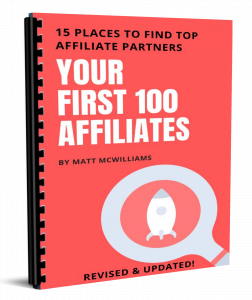 |
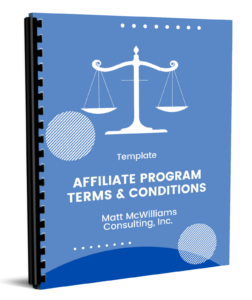 |
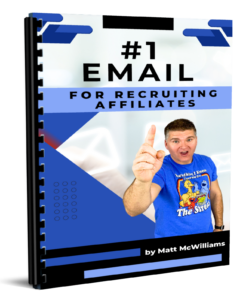 |
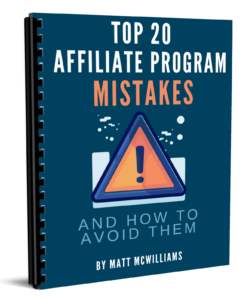 |
 |
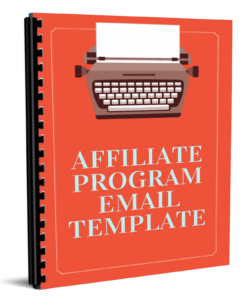 |
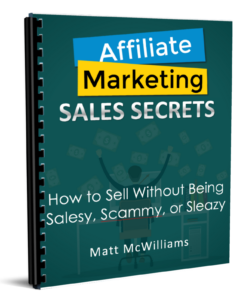 |
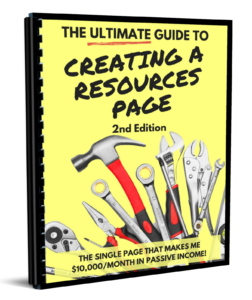 |
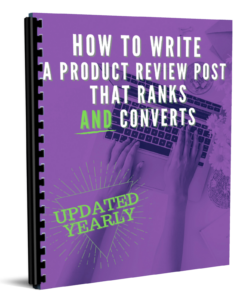 |



